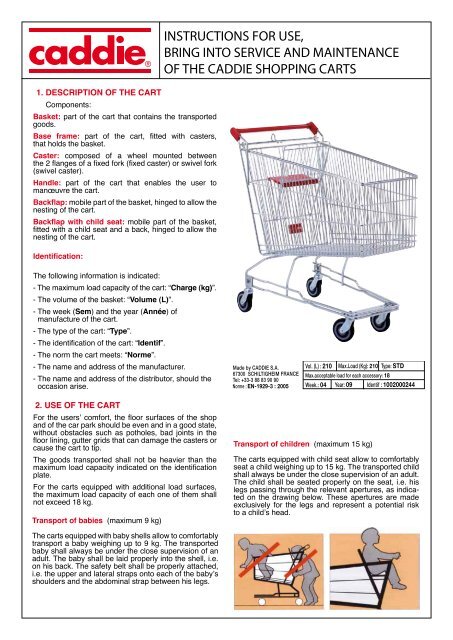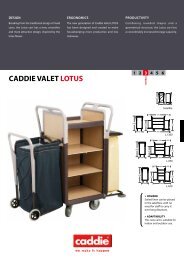instructions for use, bring into service and maintenance - Caddie
instructions for use, bring into service and maintenance - Caddie
instructions for use, bring into service and maintenance - Caddie
Create successful ePaper yourself
Turn your PDF publications into a flip-book with our unique Google optimized e-Paper software.
1. DESCRIPTION OF THE CART<br />
Components:<br />
Basket: part of the cart that contains the transported<br />
goods.<br />
Base frame: part of the cart, fitted with casters,<br />
that holds the basket.<br />
Caster: composed of a wheel mounted between<br />
the 2 flanges of a fixed <strong>for</strong>k (fixed caster) or swivel <strong>for</strong>k<br />
(swivel caster).<br />
H<strong>and</strong>le: part of the cart that enables the <strong>use</strong>r to<br />
manœuvre the cart.<br />
Backflap: mobile part of the basket, hinged to allow the<br />
nesting of the cart.<br />
Backflap with child seat: mobile part of the basket,<br />
fitted with a child seat <strong>and</strong> a back, hinged to allow the<br />
nesting of the cart.<br />
Identification:<br />
The following in<strong>for</strong>mation is indicated:<br />
- The maximum load capacity of the cart: “Charge (kg)”.<br />
- The volume of the basket: “Volume (L)”.<br />
- The week (Sem) <strong>and</strong> the year (Année) of<br />
manufacture of the cart.<br />
- The type of the cart: “Type”.<br />
- The identification of the cart: “Identif”.<br />
- The norm the cart meets: “Norme”.<br />
- The name <strong>and</strong> address of the manufacturer.<br />
- The name <strong>and</strong> address of the distributor, should the<br />
occasion arise.<br />
2. USE OF THE CART<br />
For the <strong>use</strong>rs’ com<strong>for</strong>t, the floor surfaces of the shop<br />
<strong>and</strong> of the car park should be even <strong>and</strong> in a good state,<br />
without obstacles such as potholes, bad joints in the<br />
floor lining, gutter grids that can damage the casters or<br />
ca<strong>use</strong> the cart to tip.<br />
The goods transported shall not be heavier than the<br />
maximum load capacity indicated on the identification<br />
plate.<br />
For the carts equipped with additional load surfaces,<br />
the maximum load capacity of each one of them shall<br />
not exceed 18 kg.<br />
Transport of babies (maximum 9 kg)<br />
The carts equipped with baby shells allow to com<strong>for</strong>tably<br />
transport a baby weighing up to 9 kg. The transported<br />
baby shall always be under the close supervision of an<br />
adult. The baby shall be laid properly <strong>into</strong> the shell, i.e.<br />
on his back. The safety belt shall be properly attached,<br />
i.e. the upper <strong>and</strong> lateral straps onto each of the baby’s<br />
shoulders <strong>and</strong> the abdominal strap between his legs.<br />
INSTRUCTIONS FOR USE,<br />
BRING INTO SERVICE AND MAINTENANCE<br />
OF THE CADDIE SHOPPING CARTS<br />
Made by CADDIE S.A.<br />
67300 SCHILTIGHEIM FRANCE<br />
Tel: +33-3 88 83 90 90<br />
Norme : EN-1929-3 : 2005<br />
Vol. (L) : 210 Max.Load (Kg): 210 Type: STD<br />
Max.acceptable load <strong>for</strong> each accessory: 18<br />
Week.: 04 Year: 09 Identif : 1002000244<br />
Transport of children (maximum 15 kg)<br />
The carts equipped with child seat allow to com<strong>for</strong>tably<br />
seat a child weighing up to 15 kg. The transported child<br />
shall always be under the close supervision of an adult.<br />
The child shall be seated properly on the seat, i.e. his<br />
legs passing through the relevant apertures, as indicated<br />
on the drawing below. These apertures are made<br />
exclusively <strong>for</strong> the legs <strong>and</strong> represent a potential risk<br />
to a child’s head.
Use on moving walkways<br />
When carts are <strong>use</strong>d on a moving walkway (sign on<br />
the h<strong>and</strong>le), <strong>use</strong>rs shall constantly hold the h<strong>and</strong>le of<br />
the cart <strong>and</strong> take care that the child stays perfectly<br />
seated as long as the cart is <strong>use</strong>d on the moving<br />
walkway.<br />
Only carts equipped with specially adapted casters<br />
can be <strong>use</strong>d on the moving walkways.<br />
Braking system<br />
Some carts are equipped with a braking system.<br />
It is operated by the <strong>use</strong>r to stop the cart. For example,<br />
to ensure the safety of a second child left unattended,<br />
whilst the first one is put in or out of the cart. To block<br />
the caster, push the brake lever with the foot down <strong>and</strong><br />
backward.<br />
To free the brake, push the brake lever <strong>for</strong>ward.<br />
Parking <strong>and</strong> collecting carts<br />
In the parking bays, we advise to nest files of not<br />
more than 30 carts each to avoid any risk due to<br />
overcrowding. As a matter of fact, spreading the carts’<br />
parking bays limits the waiting time <strong>for</strong> the customers<br />
as well as the walking distance.<br />
When collecting the carts, we advise you to manœuvre<br />
files of not more than 10 carts to avoid accidents.<br />
When manoeuvring files, the carts shall be strapped<br />
together in order not to damage the coin locks.<br />
In<strong>for</strong>mation panels <strong>and</strong> <strong>instructions</strong> of <strong>use</strong><br />
We advise you to put <strong>instructions</strong> of <strong>use</strong> onto in<strong>for</strong>mation<br />
panels clearly visible at the parking bays.<br />
These shall be written in the country’s language.<br />
Instructions of <strong>use</strong> pertaining to the <strong>use</strong> of moving<br />
walkways<br />
In<strong>for</strong>mation panels with <strong>instructions</strong> of <strong>use</strong>, clearly <strong>and</strong><br />
easily readable, shall be affixed permanently at the<br />
entrance of the moving walkways.<br />
These <strong>instructions</strong> are as follows:<br />
A drawing in white onto green background, according<br />
to the International Norm (ISO 3864), with dimensions<br />
of at least 80 x 80 mm.<br />
The text: “Please always hold the h<strong>and</strong>le of the cart<br />
when using the moving walkway”.<br />
The maximum load capacity of the cart (indicated on<br />
the identification plate).<br />
The transported goods shall not overlap the sides of<br />
the cart.<br />
Drawing affixed at the entrance<br />
of moving walkways<br />
<strong>and</strong> on the h<strong>and</strong>le of the cart.
3. INSTRUCTIONS FOR USE<br />
For all types of shopping carts<br />
The owner needs to maintain the shopping cart park in<br />
good condition <strong>for</strong> his customers’ <strong>use</strong>.<br />
We recommend you carry out regular checks by<br />
qualified technical staff to verify the shopping cart<br />
park <strong>and</strong> surrounding areas are in good condition. You<br />
should ensure any damaged shopping cart, that could<br />
represent a danger to the safety of your customers, be<br />
pulled to one side.<br />
The staff can then carry out a fast inspection of the<br />
shopping carts checking <strong>for</strong> the following: missing parts<br />
(which could represent a danger to the <strong>use</strong>r), state of<br />
the safety devices (h<strong>and</strong>les, protectors, bumpers, child<br />
backflap, baby shell, functioning of the brake system),<br />
cleanliness (articles left inside the baskets).<br />
Shopping carts with casters <strong>for</strong> moving walkways<br />
Shopping carts specifically designed <strong>for</strong> <strong>use</strong> on moving<br />
walkways can be recognized by the following logo on<br />
the h<strong>and</strong>le:<br />
In addition to the tests in place <strong>for</strong> traditional shopping<br />
carts, controls <strong>and</strong> trials have to be operated on site on<br />
the very moving walkways these shopping carts will be<br />
<strong>use</strong>d on.<br />
These tests should be done:<br />
Upon receipt of new shopping carts in order to ensure<br />
that they are fit <strong>for</strong> <strong>use</strong> on the existing moving walkways.<br />
On a regular basis to ensure the locking system works<br />
properly.<br />
This control should be done at least every 6 months,<br />
along with a check on all the casters’ condition.<br />
Every single time important changes or <strong>service</strong>s are<br />
operated on the moving walkway equipment or on the<br />
shopping cart fleet: following EN 115-1995.<br />
Important changes are described as follows:<br />
For moving walkways: see 16.2.2/ EN 115-1995<br />
For shopping carts: structure modifications, <strong>use</strong> of<br />
compounds <strong>and</strong> accessories other than the ones fitted<br />
as st<strong>and</strong>ard, such as new casters or locking systems<br />
coming from another supplier other than CADDIE.<br />
NOTE : Re-fitting of compounds made by CADDIE<br />
are not to be considered as important changes.<br />
The damaged or dangerous shopping carts should<br />
be removed from customer <strong>use</strong>, in order to carry out<br />
repairs/<strong>maintenance</strong>.<br />
Your staff should also check the areas where shopping<br />
carts are to be <strong>use</strong>d, to ensure the area is clear of any<br />
obstacle or any potential problem.<br />
A badly closed gutter grid, a pothole, uneven surfaces<br />
etc present the risk of capsizing the shopping carts <strong>and</strong><br />
there<strong>for</strong>e potential injury to the <strong>use</strong>rs, the transported<br />
children <strong>and</strong> baby, <strong>and</strong> the shopping cart contents.<br />
Moreover, the shopping carts <strong>use</strong>d on badly maintained<br />
surfaces are likely to be damaged quickly, ca<strong>use</strong><br />
accidents <strong>and</strong> this is likely to negate our guarantee of<br />
the trolley.<br />
It is important that controls <strong>and</strong> trials include:<br />
- A visual check of the moving walkway’s condition<br />
<strong>and</strong> cleanliness<br />
- A visual check of the shopping carts’ condition<br />
- A trial of trouble free function of locking <strong>for</strong> loaded<br />
<strong>and</strong> empty shopping carts once put onto a moving<br />
walkway<br />
- A trial of trouble free function of locking <strong>for</strong> loaded<br />
<strong>and</strong> empty shopping carts in case the emergency<br />
stop of moving walkway is operated<br />
- A trial of trouble free moving walkway entry <strong>and</strong> exit<br />
<strong>for</strong> loaded <strong>and</strong> empty shopping carts.<br />
Records<br />
In order to simplify tests <strong>and</strong> trials, we recommend that<br />
a record of the technical specification of moving walkway<br />
<strong>and</strong> shopping cart, as well as full history, is held by<br />
a competent technical staff member.<br />
These records should include:<br />
- A technical section recording first operation date<br />
<strong>and</strong> specification of shopping carts (namely max.<br />
operation load capacity, important changes <strong>and</strong><br />
compound change/addition)<br />
- A complete <strong>service</strong>, trial <strong>and</strong> control history including<br />
accident reports<br />
This record book should be held <strong>for</strong> accessibility by<br />
the <strong>maintenance</strong> department <strong>and</strong> head of security<br />
(National security authorities might define who is held<br />
responsible <strong>for</strong> these records).
4. MAINTENANCE<br />
Shopping carts face heavy duty <strong>and</strong> stress.<br />
In order to maintain a high level of h<strong>and</strong>ling com<strong>for</strong>t <strong>and</strong> good presentation, we recommend you to carry out<br />
<strong>maintenance</strong> procedures on a regular basis, as follows:<br />
Control of shopping cart’s compounds <strong>and</strong> fitting of new ones if needed.<br />
Control of shopping cart’s main function:<br />
sound h<strong>and</strong>ling <strong>and</strong> nestability.<br />
5. CADDIE SERVICE<br />
Control of coinlock’s function.<br />
Contact your local dealer: details available at www.caddie.com / section: international contacts.



